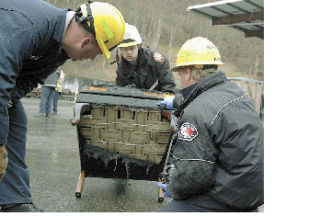“So far we’ve got some pretty good indications it started on or near a couch,” East Pierce Fire and Rescue’s Brian Schulz said as he jotted down notes he took while examining the charred remains of what once was someone’s living room. “It looks like flammable liquids may have been used to get it started.”
But it was early in the investigation and there was a lot more to do and learn.
Schulz was paired with Enumclaw firefighter Matt Williams and Matt Heinrich from Mason County Fire District No. 2 Thursday morning. The trio’s job was to sift through the remains of home that had caught fire. The threesome were collecting carpet samples and placing them in tin cans. Snapping photographs of singed lamps, tracing burn and smoke patterns and escorting wayward looky-lou neighbors out of the investigation area.
They were searching for clues that would help them determine how the fire started.
In this case, an 8-foot by 8-foot shed in the lot of a Tukwila tractor repair business served as the home in question. And Schulz, Williams and Heinrich were students working on their final exam.
They were among 22 firefighters, three from Enumclaw and some from East Pierce Fire and Resuce, the remainder from across the Puget Sound region, taking a week-long basic fire investigation course led by Mark Crowley and hosted by the Enumclaw Fire Department.
Joe Otto and John Bloomer were Enumclaw’s other representatives. Enumclaw resident Nels Petersen attended representing the Kirkland department where he works. Enumclaw’s Ben Hayman, who works for the Tukwila Fire Department, served as a leader.
Earlier in the week, firefighters roamed the streets of Enumclaw working on their interviewing skills, which they honed Thursday as they interrogated role-playing instructors who represented passers-by, homeowners, neighbors, eye witnesses and disgruntled employees.
Each of the 10 burn cells Thursday represented a different situation with a variety of variables. Some were accidental, started by fireworks, candles or cigarettes; others were set up to lead investigators toward arson. Each cell represented a different location like a room in a home – bathroom, bedroom, living room – or a business office.
Each firefighter was paired with a certified fire investigator and given access to the tools of the trade.
Just like real life, student investigators also had Henny at their disposal.
Henny is an accelerant detection K-9, who is assigned to the Seattle Fire Department Fire Investigation Unit and handler Steve Baer. The 4-year-old, female, black Labrador retriever was trained by the Bureau of Alcohol, Tobacco and Firearms (ATF). She and Baer are available 24 hours a day to assist local and federal agencies throughout the country.
The two presented firefighters with a demonstration of her skills before Thursday’s exercise.
In the classroom, students got the ins-and-outs of fire investigation including some of the nuances like working with insurance company investigators and how to team up with police departments.
Williams said it was a week of in-depth exploration. With years of fighting fires, the class provided a different perspective.
“There’s been a great deal of information I never thought about,” he said. “It’s very detail-oriented.”
Enumclaw firefighter Randy Fehr, who was overseeing the class, said it was important to certify more fire investigators and hosting the class was a way to do that and save the city some money.
“Since we moved to 24-hour shifts, we identified a need for more fire investigators,” said Fehr, who has been Enumclaw’s fire investigator since 1999 when the city moved away from using the services of King County. Buckley Fire Chief Alan Predmore is also a fire investigator and East Pierce also has a number who all work together in this area. “The state requires us to look for the origin and cause for every fire we have.”
There are four causes for fire – accidental, incendiary, natural and undetermined.
Friday, students returned to Enumclaw to present the findings of their mock investigations.
“This class is a foundation right now they can continue to build upon,” Fehr said.
A written test will be available in May.
Fehr said continued training is important since the technology continues to change.
“The field is ever evolving,” he said. “It’s never like what you see on CSI.”




